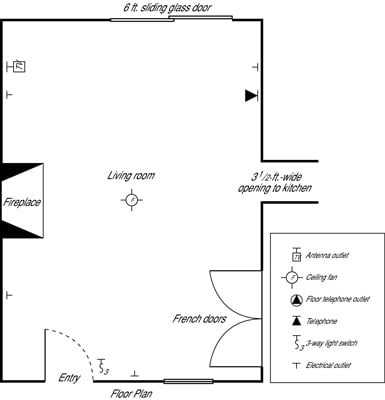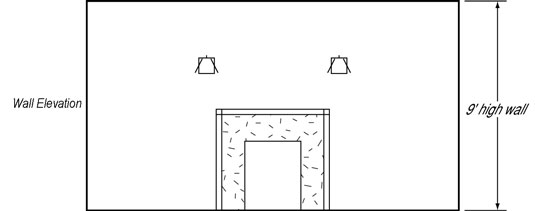How Do You Draw Doors on a Floor Plan
How to Describe a Floor Plan
Don't offset decorating without an analysis of your space and an accurate floor plan. A floor programme is the easiest way to get a handle on how much space you have, and what that space's strong and weak points are. To create an authentic flooring plan, start by measuring a room:
-
Measure along the baseboard the length of one wall, from i corner of the room to another.
For accuracy, measure to the nearest 1/4 inch. Record this number on your rough flooring plan and in your notebook.
-
Measure the remaining walls the same manner you measured the starting time.
Virtually rooms have 4 walls, but if you're measuring an 50-shaped room, you have more to measure. Include every wall in your sketch, specially if yous plan to requite one role of the room a dissimilar floor or wall roofing.
-
Mensurate the room'southward doorways and other entries.
Note whether the door opens into or out of the room and point the direction (with an arc) on your rough floor programme sketch. Too mensurate the distances of all openings — doors and open up archways — from the ends of the walls and then that you can accurately locate these openings on your terminal program.
-
Determine the size of the windows.
Include the window frame from outside edge to outside edge. Record the measurements for any moldings around the window separately. Gauge the distance from the floor to the bottom of the window frame, from the ceiling to the pinnacle of the window molding, and from the window (on each side) to the corner of the wall (or next window or opening).
-
Measure whatsoever and all architectural features, including fireplaces, brackets, shelves, and any other built-in features.
Mensurate surrounding infinite and outside or overall dimensions of these items, and then locate each on your programme.
-
Mensurate the walls from side to side and from the floor to the ceiling.
-
Measure where the electrical outlets, switches, and other controls are located.
Annotation where heat and air conditioning ducts, radiators, chases (coverings for electric wires and plumbing pipes), and exposed pipes are located.
After you lot finish measuring, yous're ready to draw your floor plan to scale:
-
Lightly pencil in the room's major areas on graph newspaper before firmly committing to hard-to-erase night lines.
Include the room's irregularities, such as support columns or any other intrusions.
-
Note on the newspaper the room's directional orientation (north, s, east, and due west).
The quantity and quality of natural light affects a number of decisions.
-
Draw the room's specifics, using a thicker straight line for walls, windows, and fireplaces.
Annotation also the within width of the doors and other openings so that yous know if your sofa (or other large slice of piece of furniture) can fit through the opening, up the stairs, or around a turn in the hallway.
-
Indicate where all permanent switches, outlets, controls, TV cablevision, and phone lines are located
These factors all influence furniture placement. Don't make the mistake of putting bookcases in front of the simply phone jack in the room, loading up all the shelves, and so discovering that you tin't plug in your phone!

-
Describe each wall'south elevations.
The wall elevations are two-dimensional representations that help y'all figure out art and accompaniment organisation or window treatment. Once again, remember to mark all the permanent features, such equally light switches, electrical outlets, phone and Television receiver cable jacks, air conditioning and heat vents, and and then on.

About This Article
About the volume authors:
Katharine Kaye McMillan, former senior editor of a New York City-based national mag, is a writer whose piece of work appears regularly in magazines and newspapers. She is a contributing writer to internationally circulated Florida Design Magazine. She is the co-writer of several books on decorating and design, including Sunday Country Style, which is the basis for licensed signature collections of article of furniture and accessories by 3 leading American manufacturers and importers. A graduate of the Academy of Texas in Austin, she holds a masters degree in psychology and is a doctoral student in psychology at Florida Atlantic University, Boca Raton, Florida. Patricia Hart McMillan is a nationally known interior designer, whose interior design work for individual clients, designer showcases, and corporations has appeared in publications worldwide, including the New York Times and USA Today. Known every bit a trend spotter and for conspicuously articulated views on pattern, she is quoted oftentimes and extensively in both trade and consumer publications. She a ppears on Boob tube and talk radio. A prolific author, she is coauthor and author of seven books on interior blueprint and decoration, with Dominicus State Fashion signature collections of piece of furniture based on ii books. She has taught decorating courses at several colleges and conducted numerous seminars across the U.S. She is decorating editor for Christian Woman Mag and reports on design trends for The Sun-Sentinel, a Tribune paper based in Ft. Lauderdale, Florida. She has been editor-in-chief of two publications and was head of a New York Urban center-based public relations firm representing some of the most prestigious names in home furnishing and building products. She holds a Bachelor of Arts caste in English, with a minor in art history (with an accent in architecture), from the State University of New York (New Paltz). She was awarded a certificate from The New York Schoolhouse of Interior Design.
This article can be found in the category:
- Decorating ,
Source: https://www.dummies.com/article/home-auto-hobbies/home-improvement-appliances/decorating/how-to-draw-a-floor-plan-181755/
0 Response to "How Do You Draw Doors on a Floor Plan"
Post a Comment